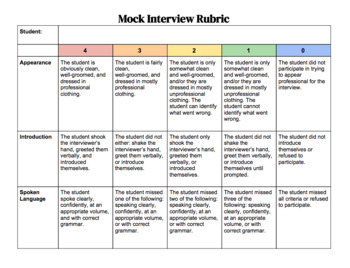Resumes are still the main tool used to make shortlisting decisions. Data shows that when humans screen resumes, they spend an average of 7.4 seconds on each resume, which is hardly enough time to read and digest the information provided. Resume screening tools aren’t much better. Candidates who know how to game the system by doing things like keyword hacking might progress to the next round while those who don’t get left behind.
Interviewing Rubrics
Implementing interview rubrics
Interview rubrics can be implemented in two different ways, manually or by using technology.
Enterprises like Amazon and Etsy implement a ‘manual’ interview rubric system to ensure consistency in hiring.
What is an interview rubric?
An interview rubric is a methodology where recruiters and hiring managers consistently ask the same series of questions. It’s a system that scores all candidate interview responses against the same set of job-based criteria. The criteria are designed to evaluate the desired skills and qualifications for a given role.
How are Technical Skills Assessed on a Rubric?
An employer may need workers with knowledge of computers, machinery or scientific equipment. Rubrics can be used to rank candidates according to their familiarity and experience with technical equipment. The hiring manager might use a scale of one to ten, or a ranking system such as expert, proficient, novice and inexperienced, to evaluate job applicants. The applicant can expect interview questions about familiarity with computer applications, computer software, construction equipment, laboratory equipment or machinery, depending on the industry.
How you can use an interview rubric to unearth the best candidates
By introducing interview rubrics early in your recruiting cycle, you can use more than a resume to screen candidates and create a shortlist of those who will progress to the next round. The beauty of interview rubrics is that they can be designed to assess hard skills like knowing how to code, as well as soft skills like knowing how to communicate well. Soft skills can determine whether or not a candidate becomes a great hire, so it makes sense to assess them as early in the recruiting process as possible. Download our guide to learn more about hiring for soft skills.
Interview rubrics can also help reduce bias by ensuring consistent questioning and analysis of candidates. Interview bias is a big issue in recruiting and so it’s important to try and eliminate or reduce its effect as much as possible. Consistent questioning and scoring is one way to minimise bias.
How is Knowledge of the Position Scored?
An interviewer might use a rubric to evaluate applicants knowledge of the position. For example, questions such as, “What skills do you have that qualify you for the job?” and “Do you meet the requirements for the position?” require answers that can be evaluated with an objective rating system. The hiring manager might rank answers based on an excellent, average or needs-improvement rating system, suggests Stetson University. Confident answers, pre-interview research about the position and job-relevant qualifications will increase an applicants score.
Rubrics help interviewers evaluate job candidates interpersonal skills. Job candidates might expect comments such as “Explain your time management and problem-solving strategies” or “Define your decision-making and communication skills.” The interviewer might rate the answers by giving points for each skill supported with job-related evidence or each highlighted skill selected on a premade checklist. The applicant should provide previous work-related examples, such as communication strategies, organizational skills and problem-solving methods used to make decisions.

